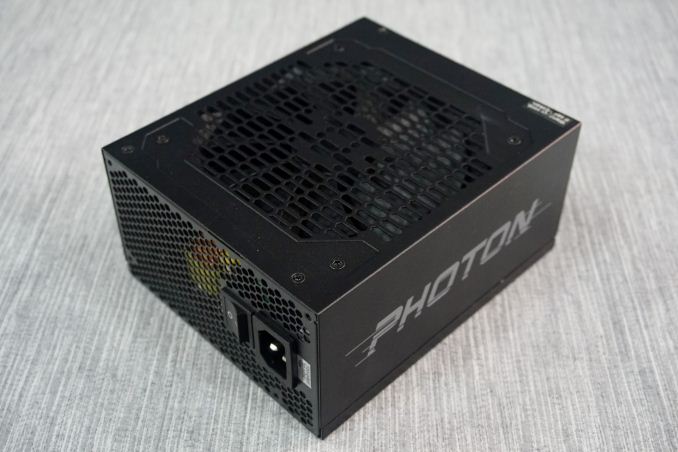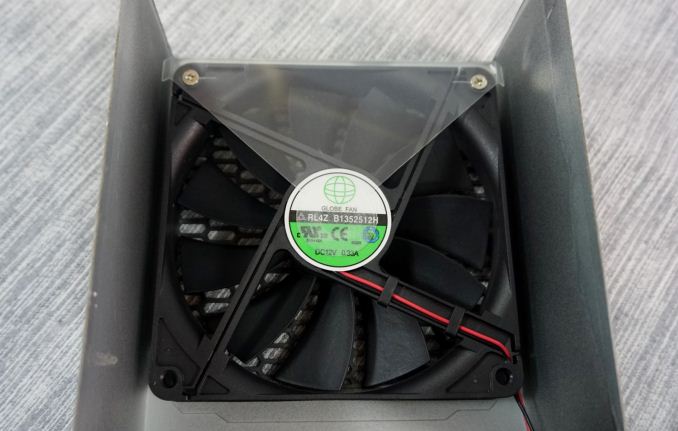The Rosewill Photon 1050W Review
by E. Fylladitakis on March 24, 2015 8:00 AM EST- Posted in
- Cases/Cooling/PSUs
- Rosewill
- 1050W
- Sirfa
External Appearance
The only thing that truly differentiates the Rosewill Photon from any other black PSU is the fan finger guard, which is not a separate part but an elongated honeycomb pattern punched on the steel chassis itself. Other than that, the series logo is printed on the right side of the chassis making it visible from a windowed side panel only if the PSU is installed with its fan facing upwards. There is absolutely nothing on the left side of the unit; the spectator will see only a plain, matte black surface from the side of a case if the unit is installed with its fan facing downwards. The sticker with the specifications of the PSU is found at the top side of the chassis.
Only the numerous connectors for the modular cables can be seen at the front of the chassis, with a basic printed legend indicating which connector corresponds to each cable. The CPU and PCI Express cables share the same connectors, while the split 10-14 pin connector is for the 24-pin ATX cable and the smaller connectors are for SATA/Molex cables.
Internal Design
A black 135mm fan from Globe is responsible for the cooling of the Photon 1050W. The B1352512H is a ball bearing fan with a maximum speed of 1500RPM, meaning that it can get significantly loud if the unit is heavily stressed. Of course, a thermal control circuitry adjusts the speed of the fan according to the load and the temperature of the unit, so we will examine how it truly behaves during our testing.
A look inside the Rosewill Photon 1050W instantly reveals that the OEM behind this unit is Sirfa, This is the same company who owns High Power as their own retail brand. Sirfa is not a bad OEM at all but it is not yet highly reputable among enthusiasts, mostly due to a few not-so-good low-cost designs they supplied through Sirtec in the past. The filtering stage is textbook, with four Y capacitors, two X capacitors and two filtering inductors. We also found a transient suppression diode and a classic fuse. There are two main rectifying bridges, sandwiched on a small, dedicated heatsink. Two large Nippon Chemi-Con 400V/390μF capacitors can be seen in the PFC stage, alongside an equally large filtering inductor. Two low resistance power transistors by Infineon form a half-bridge primary inversion stage, while eight transistors by the same company create the secondary conversion stage and generate the 12V output.
Quality wise, the Photon 1050W ranks above average, but it is not perfect. The quality of the components is outstanding; all of the main components come from reputable manufacturers - the electrolytic capacitors are all from Nippon Chemi-Con and the polymer capacitors are supplied by Fujitsu Electronics. Sirfa could improve their design and assembly quality a little though - the design is a little messy and there are several joints amateurishly soldered. These will not be a problem but they are also not something enthusiasts like to see in products that are supposed to compete in the high-end segment of the market.

























42 Comments
View All Comments
etamin - Tuesday, March 24, 2015 - link
I'm still waiting for a high quality PSU that is:300-550W
80 Plus Gold/Plat
fully modular
active cooling (preferrably a hybrid fan)
available as SFX
I would imagine it is easy for a company like Seasonic to put out such a device. If only their lower wattage Plat models had some sort of active cooling, I would be less reluctant to buy one.
phantomferrari - Wednesday, March 25, 2015 - link
You mean like these :)http://silverstonetek.com/product_power.php?tno=7&...
Jahzah_1 - Wednesday, March 25, 2015 - link
Personally, I have always gone the opposite route. The power supply is the most underrated and unappreciated component in PC building. The first reason is upgrade path. you never know if you will add other components later. As an avid AMD user, they have stuck with one socket for awhile, so having a beefier PS unit that can handle a dramatic change in TDP (with overclocking) pays dividends.The second and most important reason is the strain on the PSU itself. My rule of thumb is to try and stay under half of the rated watts of the unit. Though truth be told, the Amperage is the more important feature to account for. If i calculate my power needs to be no more than 400 watts @ 30 to 40 amps, I will always go for a min of 800 watts @ 60-80 amps. the reason is again strain. Just my personal preference. I use the car comparison the most for people building for the first time. If my car can go 150 MPH, i can't expect to maximize longevity by going that fast continuously. but at 75 MPH all parts of the car can handle that for much longer.
SirGCal - Tuesday, March 24, 2015 - link
There's more to power supplies then raw numbers. Actually I want to see how smooth and accurate the power is myself. Having more power then you need isn't bad, just cost money. Power supplies also lose power over time as they age but it takes quite a bit to make any real notice. Still, I like to keep them running well under their power band for both heat and noise. There are plenty of 500-1kW units out there that fit the budget lineup. I'm running an SLI setup now with a 750W unit and still have plenty of headroom.But what I am interested in is the power clarity and accuracy, especially in these gold and higher rated units. And unfortunately, the extremely low power supplies tend to be the cheapest, noisiest (signals), and more inaccurate units. Since power is the core of any system, stable and accurate power is paramount to a good and stable system. It's one area that I refuse to skimp on in any build. But still don't go insane at the same time. But I'd easily spend $100 for a solid, accurate, tested unit instead of a $40 Joe's Power Supply version...
chlamchowder - Tuesday, March 24, 2015 - link
What I'd like to see is how that $40 supply compares to a $100 supply - and that would include power delivery characteristics. If Anandtech would test some of those cheaper units, maybe we'll find that spending $100 on a 500W power supply is really unnecessary.Also, note that a mildly overclocked i7-4790K with a GTX 980 fits comfortably within a 500W power envelope.
kmmatney - Tuesday, March 24, 2015 - link
Between my wife and 3 kids, and my work computers (I work at home) I have 10 desktop machines at home, all fast and all used for gaming or running virtual machines or both. Most system are overclocked, and have hungry video cards. My system has a Corsair 650W system I bought 8 years ago, but most of the other systems have more modest PSUs, most of which I bought on sale for ~$40 (typically Antec Earthwatts or Rosewill 500W units). I've never had any stability problems with any of them. My server has a 500W PowerMan PSU with 6 hard drives, 2 SSDs, and a devil's Canyon i5 overclocked to 4.5 Ghz (can go higher) - this PSU came free with an InWin case I bought 5 years ago. If you have a single computer, then it makes sense to pay $90-120 on a good power supply, but when you have 10 computers to pay for, you'll find $40 (on sale) PSUs can work just fine. The motherboard already has plenty of power circuitry on it to deal with ripple, etc... I have the $45 Rosewill 450W PSU powering a hex-core OC AMD cpu + OC 560Ti video card on one system, and an overclocked G3258 + HD6850 on another system.KAlmquist - Tuesday, March 24, 2015 - link
The Seasonic SSR-360GP is by all accounts a quality PSU, and costs $60, so you don't have to spend $100 to get quality unless you need higher wattage. People who want modular cables could go with the SSR-450RM ($80), which is probably equal in quality, although I haven't purchased it and therefore didn't read the reviews carefully. Neither of these products were reviewed by Anandtech. In fact, I've never consulted an Anandtech review when buying a PSU.E.Fyll - Tuesday, March 24, 2015 - link
Well, the primary reason is that the manufacturers generally like to showcase the best they have. One company representative argued, and I partially agree, that "Someone who goes and buys a $30 PSU will not bother to check the reviews to begin with. If they are to spend >$100, they both know what they want and will check it out thoroughly before placing an order.". The other half, I will add it myself - manufacturers like to show the best they have because it reflects on their brand as a whole. If a 1.5kW PSU aces the tests, some people would (erroneously) think that their $30 unit is just as good.I do agree that the common home PC does not require more than a 500W PSU, tops. The problem is that there are actually very very very few such PSUs coming from any reputable manufacturer and even those are very basic units, based on designs and platforms that may be a decade old. There is nothing really interesting about them and the users will not actually care (although they should) if, for example, the maximum ripple is 80mV instead of 40mV.
I do try to source "small" PSUs when possible - hence the reviews of the Antec Edge 550W, the Nightjar NJ520, the Dark Power Pro 10 650W. It's not even half of the units I reviewed, I know, but it is not always possible to source small units, neither I can write a dozen PSU reviews per month.
chlamchowder - Tuesday, March 24, 2015 - link
I disagree that people going for budget PSUs won't bother to read reviews. I for one tried, until I realized such reviews were nonexistent. If someone's going so far as to pick individual parts for a computer, there's a good chance they'll care about a component as important as the PSU.Even if you don't find them interesting enough to write a review on, making some test data available would be very useful.
chlamchowder - Tuesday, March 24, 2015 - link
Also, like another poster said, there's more of a risk factor with low priced PSUs. That makes reviews (or even just raw data) even more critical.It'd be crazy to ask for 12 PSU reviews a month, but it'd be awesome if a PSU with a popular internal design gets tested, and models using the same design are just listed.
Finally, if a PSU does fail (http://www.bit-tech.net/hardware/psus/2014/06/20/5... that'd be very, very good to know.